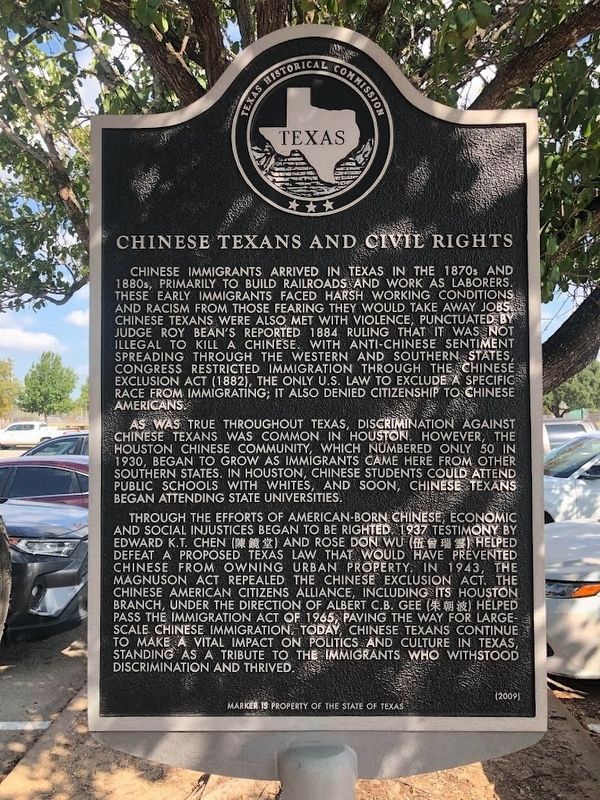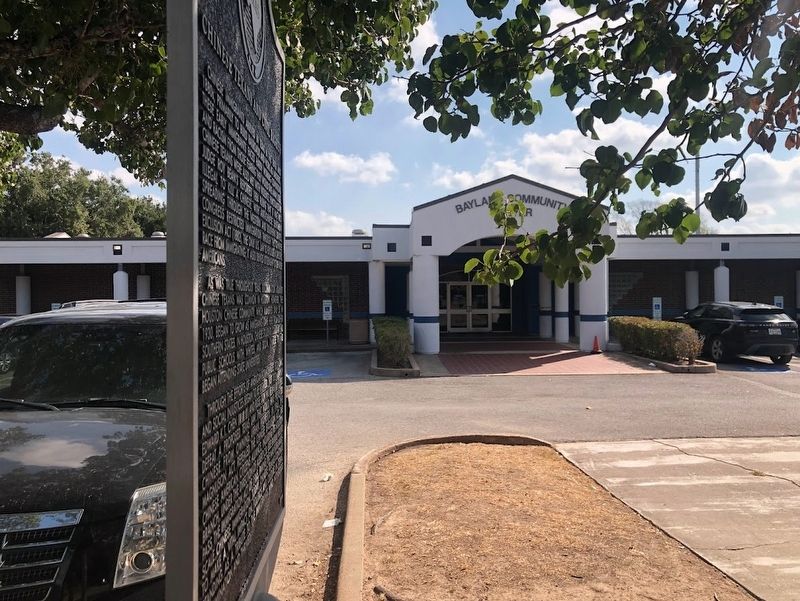Sharpstown in Houston in Harris County, Texas — The American South (West South Central)
Chinese Texans and Civil Rights
As was true throughout Texas, discrimination against Chinese Texans was common in Houston. However, the Houston Chinese community, which numbered only 50 in 1930, began to grow as immigrants came here from other southern states. In Houston, Chinese students could attend public schools with whites, and soon, Chinese Texans began attending state universities.
Through the efforts of American-born Chinese, economic and social injustices began to be righted. 1937 testimony by Edward K.T. Chen and Rose Don Wu helped defeat a proposed Texas law that would have prevented Chinese from owning urban property. In 1943, the Magnuson Act repealed the Chinese Exclusion Act. The Chinese American Citizens Alliance, including its Houston branch, under the direction of Albert C.B. Gee helped pass the immigration act of 1965, paving the way for large-scale Chinese immigration. Today, Chinese Texans continue to make a vital impact on politics and culture in Texas, standing as a tribute to the immigrants who withstood discrimination and thrived.
Erected 2014 by Texas Historical Commission. (Marker Number 16254.)
Topics. This historical marker is listed in these topic lists: Asian Americans • Civil Rights • Immigration • Settlements & Settlers. A significant historical year for this entry is 1884.
Location. 29° 41.691′ N, 95° 29.811′ W. Marker is in Houston, Texas, in Harris County. It is in Sharpstown. Marker is on Bissonnet Street, 0.1 miles west of Hillcroft Avenue. This marker is located in Bayland Park, in the median of the parking lot next to the park's community center. Touch for map. Marker is at or near this postal address: 6400 Bissonnet Street, Houston TX 77074, United States of America. Touch for directions.
Other nearby markers. At least 8 other markers are within 4 miles of this marker, measured as the crow flies. Bellaire (approx. 1.8 miles away); Bellaire Streetcar Line (approx. 1.9 miles away); Bellaire Presbyterian Church (approx. 1.9 miles away); Texan Capture of Mexican Dispatches (approx. 2.1 miles away); Beth Yeshurun Synagogue
(approx. 2.6 miles away); Hamilton Shirts (approx. 2.8 miles away); Teas Nursery Company (approx. 2.9 miles away); Temple Lodge No. 4 A.F. & A.M. (approx. 3.6 miles away). Touch for a list and map of all markers in Houston.
Also see . . . Official Texas Historical Marker Dedicated to Chinese Texans and Civil Rights. An article by the Chinese American Citizens Alliance about the dedication of this Texas historical marker on May 23, 2014. (Submitted on September 5, 2023, by Sean Flynn of Oak Park, Illinois.)
Credits. This page was last revised on September 5, 2023. It was originally submitted on September 5, 2023, by Sean Flynn of Oak Park, Illinois. This page has been viewed 110 times since then and 58 times this year. Photos: 1, 2. submitted on September 5, 2023, by Sean Flynn of Oak Park, Illinois. • James Hulse was the editor who published this page.

